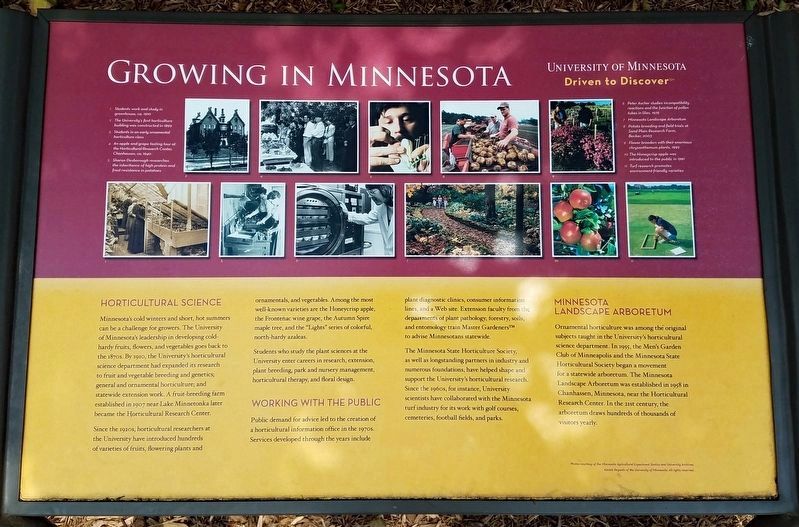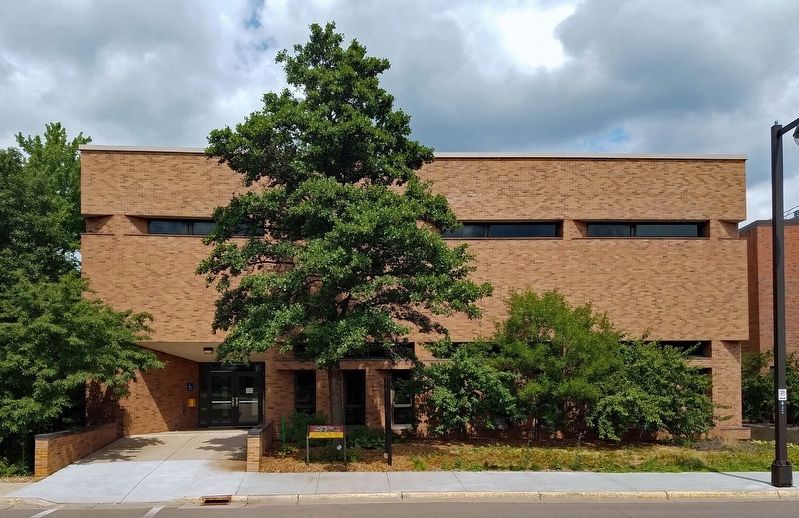Falcon Heights in Ramsey County, Minnesota — The American Midwest (Upper Plains)
Growing in Minnesota
Horticultural Science
Minnesota's cold winters and short, hot summers can be a challenge for growers. The University of Minnesota's leadership in developing cold-hardy fruits, flowers, and vegetables goes back to the 1870s. By 1910, the University's horticultural science department had expanded its research to fruit and vegetable breeding and genetics; general and ornamental horticulture; and statewide extension work. A fruit-breeding farm established in 1907 near Lake Minnetonka later became the Horticultural Research Center.
Since the 1920s, horticultural researchers at the University have introduced hundreds of varieties of fruits, flowering plants and ornamentals, and vegetables. Among the most well-known varieties are the Honeycrisp apple, the Frontenac wine grape, the Autumn Spire maple tree, and the "Lights" series of colorful, north-hardy azaleas.
Students who study the plant sciences at the University enter careers in research, extension, plant breeding, park and nursery management, horticultural therapy, and floral design.
Working with the Public
Public demand for advice led to the creation of a horticultural information office in the 1970s. Services developed through the years include plant diagnostic clinics, consumer information lines, and a Web site. Extension faculty from the departments of plant pathology, forestry, soils, and entomology train Master Gardeners to advise Minnesotans statewide.
The Minnesota State Horticulture Society as well as longstanding partners in industry and numerous foundations, have helped shape and support the University's horticultural research. Since the 1960s, for instance, University scientists have collaborated with the MInnesota turf industry for its work with golf courses, cemeteries, football fields, and parks.
Minnesota Landscape Arboretum
Ornamental horticulture was among the original subjects taught in the University's horticultural science department. In 1955, the Men's Garden Club of Minneapolis and the Minnesota State Horticultural Society began a movement for a statewide arboretum. The Minnesota Landscape Arboretum was established in 1958 in Chanhassen, Minnesota, near the Horticultural Research Center. In the 21st century, the arboretum draws hundreds of thousands of visitors yearly.
Captions:
1. Students work and study in greenhouse, ca. 1910
2. The University's first horticulture building was constructed in 1899
3. Students in an early ornamental horticulture class
4. An apple and grape tasting tour at the Horticultural Research Center, Chanhassen, ca. 1940
5. Sharon Desborough researches the inheritance of high protein and frost resistance in potatoes
6. Peter Ascher studies incompatibility reactions and the function of pollen tubes in lilies, 1876
7. Minnesota Landscape Arboretum
8. Potato breeding and field trials at Sand Plain Research Farm, Becker, 2003
9. Flower breeders with their enormous chrysanthemum plants, 1992
10. The Honeycrisp apple was introduced to the public in 1991
11. Turf research promotes environment-friendly varieties
Erected 2009 by Regents of the University of Minnesota.
Topics. This historical marker is listed in these topic lists: Education • Horticulture & Forestry • Science & Medicine. A significant historical year for this entry is 1870.
Location. 44° 59.238′ N, 93° 11.035′ W. Marker is in Falcon Heights, Minnesota, in Ramsey County. Marker is on Upper Buford Circle north of Buford Circle, on the right when traveling north. The marker is on the Saint Paul Campus of the University of Minnesota, at the southwest entrance of Alderman Hall. Touch for map. Marker is at or near this postal address: 1970 Folwell Avenue, Saint Paul MN 55108, United States of America. Touch for directions.
Other nearby markers. At least 8 other markers are within walking distance of this marker. Agricultural Excellence (about 300 feet away, measured in a direct line); The Goldstein Legacy (approx. 0.2 miles away); The St. Paul Campus (approx. ¼ mile away); Extending the U (approx. ¼ mile away); Old Anatomy Building (approx. 0.3 miles away); Veterinary Medicine (approx. 0.3 miles away); World War I Memorial Grove (approx. 0.4 miles away); A Century in the Sky (approx. 0.9 miles away). Touch for a list and map of all markers in Falcon Heights.
Credits. This page was last revised on November 26, 2021. It was originally submitted on November 21, 2021, by McGhiever of Minneapolis, Minnesota. This page has been viewed 100 times since then and 9 times this year. Photos: 1, 2. submitted on November 21, 2021, by McGhiever of Minneapolis, Minnesota. • J. Makali Bruton was the editor who published this page.

